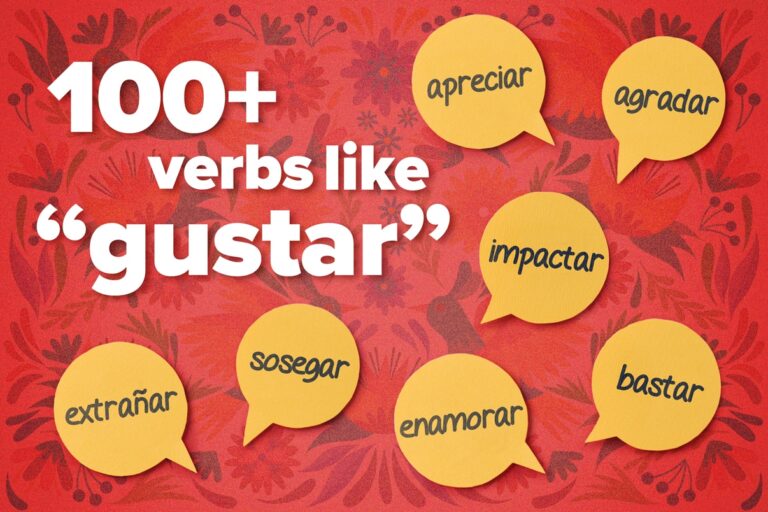7 Tips to Significantly Improve Your Spanish Accent

Have you ever felt self-conscious about your Spanish accent or struggled to pronounce certain words?
I’ve been there too, and I’m here to help you fine-tune your pronunciation and infuse your Spanish with an authentic touch. In this article, you’ll learn seven useful tricks to get rid of that pesky foreign accent and sound more like a native Spanish speaker.
Download: This blog post is available as a convenient and portable PDF that you can take anywhere. Click here to get a copy. (Download)
1. Learn the Correct Vowel Sounds
Luckily for you and me, Spanish pronunciation is quite regular. Unlike English vowels, each Spanish vowel has exactly one sound:
- A is pronounced like the “a” in “father.” For example, amor (love).
- E is pronounced like the “e” in “bed.” For example, elefante (elephant).
- I is pronounced like the “ee” in “see”. For example, caliente (hot).
- O is pronounced like the “o” in “go.” For example, oso (bear).
- U is pronounced like the “oo” in “too.” For example, uva (grape).
Of course, there are rules for Spanish diphthongs and the dieresis. But those are your five basic vowel sounds.
There are a ton of free resources on YouTube to help you learn and reinforce the Spanish vowel sounds. Personally, I recommend starting with this hilariously outdated video.
Yes, the video is silly. But it’s also quite helpful. Do you notice how, when pronouncing a word, the student says every vowel with the same crisp, clear sound? Every “e” in excelente sounds exactly the same as the one before it.
One big problem that English speakers tend to have with Spanish is inserting diphthongs where they don’t belong, so that a word like excelente comes out sounding more like “excelentay.” Another common problem is pronouncing Spanish words with English vowels, so that a word like cerveza (beer) incorrectly becomes “sir-VAY-zuh.”
The trick is to practice making clear, consistent vowel sounds that don’t change: ah, eh, ee, oh, ooh. Try to hold each sound for several seconds without changing the shape of your mouth. Then, practice inserting the sounds into words.
2. Pay Attention to Accent Marks
As mentioned previously, Spanish pronunciation follows regular rules. So it shouldn’t surprise you that there’s a very simple rule for knowing which syllable gets the stress in a Spanish word. It breaks down like this:
By default, put the stress on the second-to-last syllable of a word. Casa (house), manzana (apple), domingo (Sunday), and amarillo (yellow) are all words that follow this example.
The only exceptions are words that end in consonants other than “n” and “s.” In these cases, stress the last syllable of the word. Think of words like hablar (talk), ordenador (computer), pincel (paintbrush) and cicatriz (scar).
Any words that stray from this pattern will be conveniently marked with an accent—a little line above a vowel that lets you know to stress that syllable. See, for example, words like miércoles (Wednesday), dímelo (tell me), escocés (Scottish) and habrá (there will be).
In spoken Spanish, accent marks can be of crucial importance. Take, for example, the totally innocuous sentence “Como papas” (I eat potatoes.) Following the simple rules laid out above, we know that this sentence is pronounced, “Como papas.”
Stress the wrong syllables and you’ll end up with the sentence, “Como papás,” or “I eat fathers.” Yikes!
Mind your accent marks and learn which syllable to stress—it can make the difference between comprehension and utter confusion.
Over time, knowing which syllable to accent will become intuitive. Until then, here’s an exercise to help you practice: Find a passage of Spanish text that you also have a recording of. (For example: lyrics to a song, an audiobook that you also have a hard copy of, a listening exercise from a textbook, etc.) Without listening to the recording, underline the syllable in each word that gets the stress. Then, listen to the recording and check your answers.
3. Soften Your T’s and D’s
Let’s do an experiment. Try saying the following phrase out loud: “Two fantastic tigers.”
Pay attention: Where does your tongue go when you make the “t” sound? If you are like most English speakers, it probably hits the roof of your mouth.
In Spanish, t’s are not pronounced the same way. When making a “t” sound in Spanish, press the tip of your tongue against the top of your front teeth. This produces a softer, gentler “t” sound like in tiempo (time/weather) and guitarra (guitar).
Try it out on the very useful phrase, “Tú tomaste tequila hasta las tres de la mañana.” (You drank tequila until three in the morning.)
“D” sounds also undergo a slight change. For example, try saying “Diana’s adorable dogs.” Where does your tongue end up? Probably the roof of your mouth again.
In Spanish, you must make the “d” sound with your tongue barely touching the back of your top teeth. In this case, the result is a much softer sound, almost like the English “th” in the word “this.” For example, madre (mother) and día (day).
Go ahead and practice with the following phrase: “Soy de los Estados Unidos. ¿De dónde es usted?” (I’m from the United States. Where are you from?)
This video by Learn Spanish Right offers a great comparison of the English and Spanish “d” sounds.
The differences between these sounds may seem trivial. It’s true, a Spanish speaker will probably understand you just fine if you use the English “t” and “d” sounds in your Spanish. But focusing on details like these will help you lose your foreign accent and speak Spanish like a native.
If you’re having trouble perfecting the finer points of the Spanish accent, consider making a recording of yourself reading a passage of Spanish aloud. Remember that text/audio resource from the previous point? Now would be a great time to use that again! Record yourself reading the passage aloud in your best Spanish accent, and then listen back.
You’ll be able to pick out the areas that need improvement much more clearly than you would while speaking. Now, compare your recording with the native speaker’s. Do your t’s and d’s sound like theirs? If not, try reading aloud again.
4. Perfect Your R Fuerte
The letter “r” in Spanish makes two different sounds: the r suave, or soft r (like in caro — expensive) and the r fuerte, or strong r (like in carro — car).
I’ll focus on the r fuerte, commonly referred to as a rolled “r,” because it’s one of the most difficult sounds for English speakers to master. Some people seem to pick it up intuitively, while others need to put forth a concerted effort to learn to roll their r’s. If you’re struggling, don’t worry—you’re definitely not alone!
Here are some tips if you just can’t seem to roll your r’s:
- Pretend you are purring like a cat.
- To learn the proper tongue placement, try saying the word “butter” over and over again very quickly. The spot that your tongue hits on the “tt” in “butter” is the spot where it should be when you roll your r’s.
- To strengthen the tongue muscles required to make this sound, say “tee-dee-va” quickly over and over whenever you can—while you’re driving, washing the dishes, during commercials, etc.
- Put the tip of your tongue against the roof of your mouth. Exhale, and pretend your tongue is a flag flapping in the wind. The movement of your tongue quickly hitting against the roof of your mouth will produce the sound of a rolled “r.”
- Bonus tip: A friend of mine who spent years learning to roll her r’s insists that it’s far easier to achieve after a beer or two. She says that beer helped loosen her tongue muscles. That advice may or may not work for you, but it worked for her, and either way, you get to enjoy a few drinks and practice your Spanish!
Now that you’re well on your way to making a perfect r fuerte sound, here is a run-down of when to use it:
- A single “r” after the letters “l,” “n,” or “s”: alrededor (around), enriquecer (to enrich)
Feeling brave? Practice your “r” fuerte with this tongue twister:
Rosa Rizo reza en ruso, en ruso reza Rosa Rizo.
(Rosa Rizo prays in Russian, in Russian prays Rosa Rizo.)
5. Mind Your Z’s
There are actually two correct ways to pronounce the Spanish “z,” depending on where you are in the world.
| Spanish "z" pronunciations | Regions where it's used | Pronunciation | Examples |
|---|---|---|---|
| seseo | all of Latin America, parts of southern Spain and the Canary Islands | "z" is pronounced like an English "s" | zapato (shoe) zorro (fox) rechazar (to reject or refuse) |
| ceceo | the rest of Spain and Equatorial Guinea | "z" makes a sound like the "th" in the English word "tooth" | zapato zorro rechazar |
Both ways are correct, but what you’ll never hear in Spanish is a “z” that sounds like it does in the English word “buzz.”
My personal favorite listening resource for hearing the two different Spanish “z” sounds is the song “Bailando,” sung by Spanish-born Enrique Iglesias and Cuban-born Descemer Bueno. In the first verse of the song, you can clearly hear both “z” sounds in the word corazón (heart):
Enrique Iglesias: Cuando tú me miras se me sube el corazón
Descemer Bueno: Me palpita lento el corazón
The first time around, you’ll hear the ceceo (the “th” sound), and the second time, the seseo (the “s” sound).
“Bailando” is peppered with examples of both “s” sounds, in words like cerveza (beer), cabeza (head) and abrazarte (hug you).
A song like “Bailando,” with its mix of accents and its many repeated lines, makes for a perfect speaking practice exercise! Read through the lyrics out loud phrase-by-phrase until you feel confident in your pronunciation.
Then, try to sing along with the recording to practice fluidity. Singing in Spanish is a super fun exercise that works your pronunciation while also providing a lesson in grammar, vocabulary and culture. Best of all, you can do it in the car, in your bedroom, or basically anywhere you want.
Not into Enrique Iglesias? There are tons of other z-heavy Spanish songs to practice this particular skill. Try Celia Cruz’s “Azúcar negra” or Kudai’s “Tal vez.”
6. Link Your Words
If you listen closely to native Spanish speakers talking, you’ll notice that they link or blend certain words together.
When will Spanish speakers link words?
- When the last letter of one word is the same as the first letter of the next word. For example, the phrase “dos senderos” (two trails) would sound more like “dosenderos.”
- When the last letter of one word is a consonant and the first letter of the next word is a vowel. The question “¿Estás enfadado?” (Are you angry?) would sound more like “¿Estásenfadado?”
- When the last letter of one word and the first letter of the next word are both vowels, like in the sentence “Ella está enamorada.” (She is in love.) To the untrained ear, this phrase would sound like one long word: ellaestáenamorada.
Learning this technique will not only improve your Spanish accent. At the same time, it’ll train your listening skills. As you practice blending and linking your own words, you’ll find yourself better equipped to understand what other speakers are saying when they do the same.
For a great listening resource, check out this website, which provides clear examples of each of the three types of linking. The website’s audio examples compare how the words sound un-linked and then linked. To practice, simply repeat after the recordings provided on the website.
7. Listen to Native Speakers
The best way to reinforce all of the above is, of course, to actively listen to native speakers and copy what they do.
If you’re lucky enough to be able to learn Spanish by immersion easily in your hometown or abroad, this won’t be a problem. Otherwise, try to find a language exchange partner that you can practice with in person or online.
If you want to work with someone who’s more qualified to give you personalized feedback, hire a Spanish tutor. The internet has brought us closer to capable language tutors from all around the globe. Since there are so many Spanish tutors available online, you can find one that fits your budget and schedule.
Start seeking out your own Spanish tutor on Verbling, the main online hub for tutors and students. You can sort through hundreds of Spanish tutors and choose one based on student reviews, experience, price range, region, other languages spoken and availability.
You can also try listening to a Spanish-language news program, TV show or podcast. Listen to a few sentences at a time, then pause and try to repeat back what you’ve heard. Or could try FluentU, a website and app that makes language lessons out of videos from real Spanish media where you can hear native speakers in action and follow along with the subtitles.
FluentU takes authentic videos—like music videos, movie trailers, news and inspiring talks—and turns them into personalized language learning lessons.
You can try FluentU for free for 2 weeks. Check out the website or download the iOS app or Android app.
P.S. Click here to take advantage of our current sale! (Expires at the end of this month.)

FluentU also has a YouTube channel with in-depth lessons using popular TV shows. Like this one, which is a deep-dive of a “Friends” episode in Spanish:
Start implementing these fixes today, and you’ll soon be sounding more like a native Spanish speaker.
Practice with a language partner or tutor, with a Spanish-speaking friend or even at home in the mirror!
Download: This blog post is available as a convenient and portable PDF that you can take anywhere. Click here to get a copy. (Download)
And One More Thing…
If you've made it this far that means you probably enjoy learning Spanish with engaging material and will then love FluentU.
Other sites use scripted content. FluentU uses a natural approach that helps you ease into the Spanish language and culture over time. You’ll learn Spanish as it’s actually spoken by real people.
FluentU has a wide variety of videos, as you can see here:

FluentU brings native videos within reach with interactive transcripts. You can tap on any word to look it up instantly. Every definition has examples that have been written to help you understand how the word is used. If you see an interesting word you don’t know, you can add it to a vocab list.

Review a complete interactive transcript under the Dialogue tab, and find words and phrases listed under Vocab.

Learn all the vocabulary in any video with FluentU’s robust learning engine. Swipe left or right to see more examples of the word you’re on.

The best part is that FluentU keeps track of the vocabulary that you’re learning, and gives you extra practice with difficult words. It'll even remind you when it’s time to review what you’ve learned. Every learner has a truly personalized experience, even if they’re learning with the same video.
Start using the FluentU website on your computer or tablet or, better yet, download the FluentU app from the iTunes or Google Play store. Click here to take advantage of our current sale! (Expires at the end of this month.)







